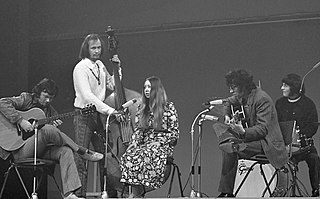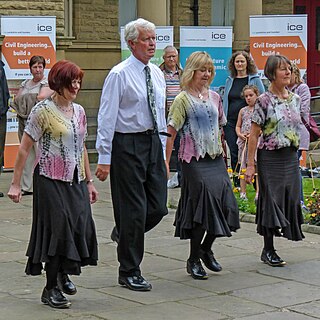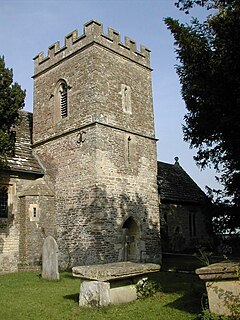
Morris dance is a form of English folk dance usually accompanied by music. It is based on rhythmic stepping and the execution of choreographed figures by a group of dancers, usually wearing bell pads on their shins. Implements such as sticks, swords and handkerchiefs may also be wielded by the dancers. In a small number of dances for one or two people, steps are near and across a pair of clay tobacco pipes laid one across the other on the floor. They clap their sticks, swords, or handkerchiefs together to match with the dance.

Hoodening, also spelled hodening and oodening, is a folk custom found in Kent, a county in south-eastern England. The tradition entails the use of a wooden hobby horse known as a hooden horse that is mounted on a pole and carried by an individual hidden under a sackcloth. Originally, the tradition was restricted to the area of East Kent, although in the twentieth century it spread into neighbouring West Kent. It represents a regional variation of a "hooded animal" tradition that appears in various forms throughout the British Isles.

The folk music of England is tradition-based music, which has existed since the later medieval period. It is often contrasted with courtly, classical and later commercial music. Folk music has been preserved and transmitted orally, through print and later through recordings. The term is used to refer to English traditional music and music composed, or delivered, in a traditional style. English folk music has produced or contributed to several important musical genres, including sea shanties, jigs, hornpipes and dance music, such as that used for Morris dancing. It can be seen as having distinct regional and local variations in content and style, particularly in areas more removed from the cultural and political centres of the English state, as in Northumbria, or the West Country. Cultural interchange and processes of migration mean that English folk music, although in many ways distinctive, has particularly interacted with the music of Scotland. It has also interacted with other musical traditions, particularly classical and rock music, influencing musical styles and producing musical fusions, such as British folk rock, folk punk and folk metal. There remains a flourishing sub-culture of English folk music, which continues to influence other genres and occasionally gains mainstream attention.
Border Morris is a collection of individual local dances from villages along the English side of the Wales–England border in the counties of Herefordshire, Worcestershire and Shropshire. They are part of the Morris dance tradition.

Cecil James Sharp was the founding father of the folk-song revival in England in the early 20th century. He gathered thousands of tunes both from rural England and the Southern Appalachians region of the United States, and wrote an influential volume, English Folk Song: Some Conclusions. He also revived the extinct tradition of English country dance, based on his study of surviving rural folk dances as well as written sources; this form of dance as Sharp revived it has by now been actively maintained by enthusiast participants for over a century. Sharp promoted Morris dancing, and in 1911 founded the English Folk Dance Society.

Towersey Festival is an annual festival of folk, world music and traditional dance, previously held in the village of Towersey, now relocated to neighbouring Thame in Oxfordshire, England. It has taken place every August bank holiday weekend since its founding in 1965.

Jack in the Green, also known as Jack o' the Green, is an English folk custom associated with the celebration of May Day. It involves a pyramidal or conical wicker or wooden framework that is decorated with foliage being worn by a person as part of a procession, often accompanied by musicians.

Clog dancing is a form of step dance characterised by the wearing of inflexible, wooden soled clogs. Clog dancing developed into its most intricate form in the North of England, Lancashire, Yorkshire, Durham and the Lake District.

Madras College, often referred to as Madras, is a Scottish secondary school located in St Andrews, Fife. It educates over 1,400 pupils aged between 11 and 18 and was founded in 1833 by the Rev. Dr Andrew Bell.
Janet Blunt (1859–1950) was a folklorist.

Mary Neal CBE, born Clara Sophia Neal, was an English social worker and collector of English folk dances.
Maud Karpeles was a British collector of folksongs and dance teacher.
Dr. Anthony Grant Barrand is an academic and musician residing in Brattleboro, Vermont. He is a Professor Emeritus of Anthropology, College of Arts and Sciences, Boston University, where his courses included "Stalking the Wild Mind: The Psychology and Folklore of Extra-Sensory Perception and Psychic Phenomena", "English Ritual Dance and Drama", and "Folk Songs as Social History".
The Hong Kong Morris is an English morris dancing team or side founded in Hong Kong in 1974. The side now has two chapters, the Hong Kong Morris in Hong Kong and the Hong Kong (UK) Morris, colloquially known as The Brackets, in the United Kingdom. In its heyday, in the late 1980s and early 1990s, the Hong Kong Morris was one of the largest Cotswold morris sides in the world. The side is committed to the principles of multiculturalism and inclusivity, and has always encouraged a multicultural membership and mixed dancing. The return of the former British colony of Hong Kong to China in 1997 has had no effect on the side's activities, and it continues to flourish as a notable example of the resilience of Western cultural activity in postcolonial Hong Kong.
Roy Leonard Dommett was a British engineer and rocket scientist, and the United Kingdom's Chief Missile Scientist, who for many years led the United Kingdom's research and development of both ballistic missiles and space rockets for the delivery of satellites into orbit. In retirement he lived in Hampshire.

Morris: A Life with Bells On is a 2009 British independent film, a comic spoof documentary about morris dancing.
A crowdy-crawn is a wooden hoop covered with sheepskin used as a percussion instrument in western Cornwall at least as early as 1880. It is similar to the Irish bodhrán. It is used by some modern Cornish traditional music groups as a solo or accompaniment instrument. The name crowdy-crawn is derived from the Cornish "croder croghen," literally "skin sieve," sometimes shortened to "crowd."
Sam Carter is a British guitarist, singer and songwriter, originally from the English Midlands but more recently based in East London. He has released two albums of mainly original material which fall loosely into the folk/roots category. Carter is the winner of the "Horizon" award for best newcomer at the BBC Radio 2 Folk Awards in 2010. Highly regarded as an instrumentalist, contemporary Jon Boden of Bellowhead described him as 'the finest English-style finger-picking guitarist of his generation,' and former BBC Radio Two folk show presenter Mike Harding wrote that Carter was "one of the most gifted acoustic guitarists of his generation.". As a songwriter, Carter marries a traditionally English narrative style with elements of American gospel and R&B and has been described as an "impressively original" performer. Some commentators consider that Carter's guitar and vocal style is similar to that of noted British iconoclasts John Martyn and Roy Harper, whilst his lyrical perspective has further invited comparison with the work of Richard Thompson.



















